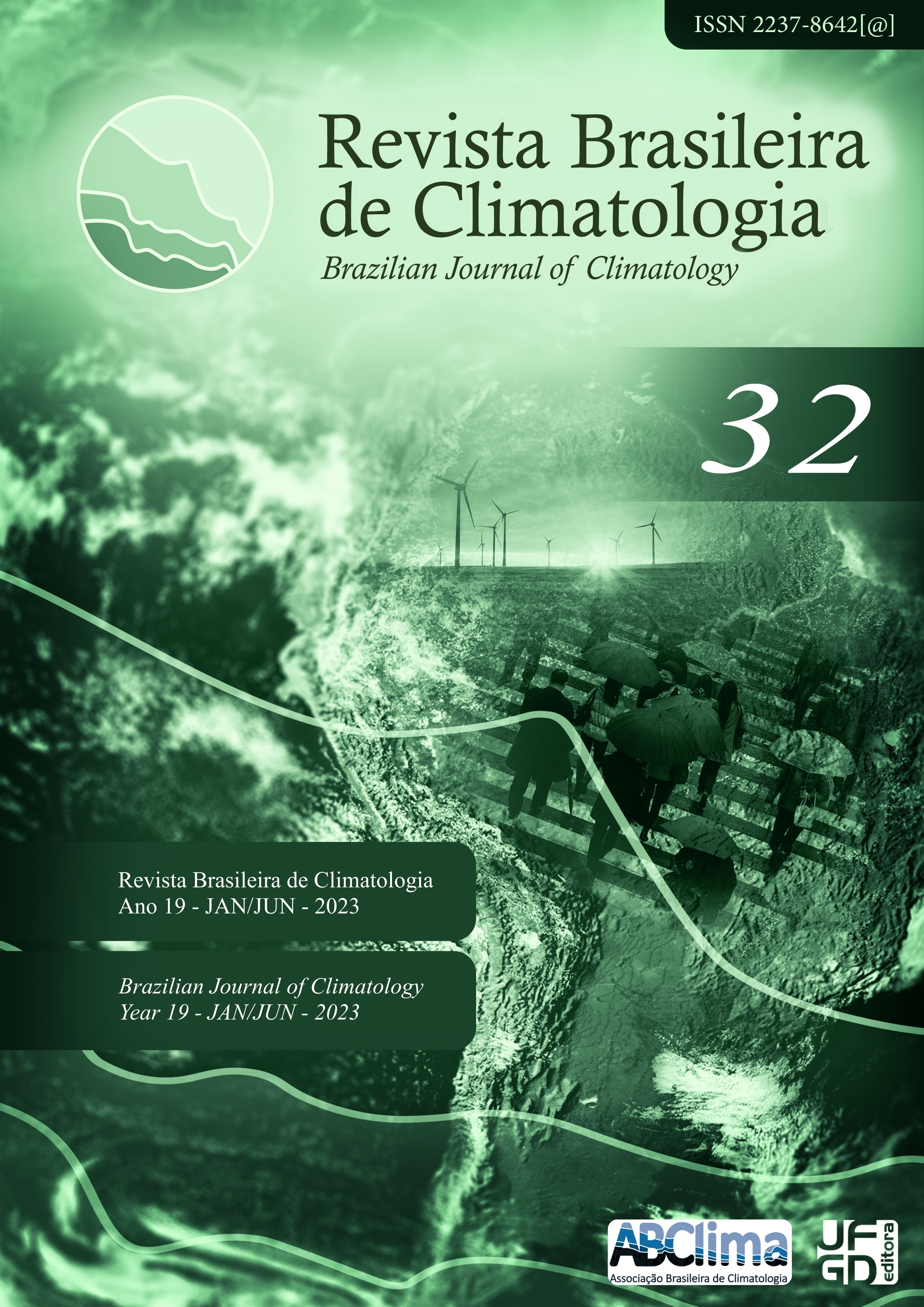Analysis of the climate features of Tangará da Serra/MT – BR, from the climate year of reference [TRY] and the climate normals of the city
DOI:
https://doi.org/10.55761/abclima.v32i19.16571Keywords:
Climate variables., Bioclimatic strategies., Sustainability.Abstract
Climate features of a region can be considered crucial for the development of sustainable architecture projects, since buildings designed for local climate provide reduction in energy demand, both in summer and winter. This way, the article aims to determine the reference climatic year (TRY) for Tangará da Serra, Mato Grosso; develop the bioclimatic chart from the data of the corresponding year and compare the results to those derived from the climatological normals. For this, it was performed the treatment of historical data from records of weatherstations of the National Institute of Meteorology (INMET) and the Technological Center of Geoprocessing and Remote Sensing applied to the production of biodiesel - CETEGEO-SR; installed at the University of the State of Mato Grosso – UNEMAT, in Tangará da Serra. Graphs and tables were created based on them, in order to compose the interpretation of the achieved results. As results, 2009 was obtained as the climate year of reference and the percentage values corresponding to the bioclimate zones in which the city is inserted in relation to this year. This way, it can be concluded that the city has comfortable climate conditions, being inserted in Zone 01 (Comfort) in 53.36% hours/year. The following main strategies were identified: natural ventilation (26.36% hours/year), and natural ventilation associated with high thermal inertia and evaporative cooling (16.49% hours/year). The conclusions were similar to those reached with climatological normals, given that the main bioclimate strategies evidenced by this were the same as those proposed with the use of TRY.
Downloads
References
ANDRADE, S.F. Estudo de estratégias bioclimáticas no clima de Florianópolis. Florianópolis, 1996. Dissertação (Mestrado em Engenharia) – Universidade Federal de Santa Catarina, SC.
ASHRAE, (1993). Weather Data and Design Conditions. In: ASHRAE Handbook - Fundamentals, New York, cap. 24, 1993.
BARBETTA, P. A. Estatística Aplicada às Ciências Sociais. 5° Ed. Editora da UFSC, 2002.
CARLO, J. C. Processamento de aquivos climáticos para simulação do desempenho energético de edificações. Florianópolis: UNIVERSIDADE FEDERAL DE SANTA CATARINA, 28 de fevereiro de 2005.
CASTANHEIRA, N. Estatística aplicada a todos os níveis. 2. Ed. Curitiba: Ibpex, 2005.
DALLACORT, R, et al. Distribuição das chuvas no município de Tangará da Serra, médio norte do Estado de Mato Grosso, Brasil. Acta Scientiarum. Agronomy. Maringá, v. 33, n2, p. 193-200, 2011. Disponível em: < http://www.scielo.br/pdf/asagr/v33n2/01.pdf >, acesso em janeiro de 2019. DOI: https://doi.org/10.4025/actasciagron.v33i2.5838
DALLASTRA, M. et al. BIOCLIMATIC STRATEGIES FOR THE CITY OF TANGARÁ DA SERRA / MT - BRAZIL. Revista Brasileira de Climatologia, p. 399–423, Vol. 25, jul/dez 2019. DOI: https://doi.org/10.5380/abclima.v25i0.66379
DOE. United States Department of Energy. Weather data. Disponível em: http://apps1.eere.energy.gov/buildings/energyplus/weatherdata_about.cfm, 2015.
GIVONI, Baruch. Comfort Climate Analysis and Building Design Guidelines. Energy and Buildings, 1992. DOI: https://doi.org/10.1016/0378-7788(92)90047-K
GOULART, S.; LAMBERTS, R.; FIRMINO, S. Dados climáticos para projeto e avaliação energética de edificações para 14 cidades brasileiras. Florianópolis: PROCEL/Núcleo de Pesquisa em Construção; UFSC, 1998.
INSTITUTO NACIONAL DE METEOROLOGIA - INMET. Ministério da Agricultura, pecuária e Abastecimento. Normais Climatológicas do Brasil. Diposnível em: < http://www.inmet.gov.br/portal/index.php?r=clima/normaisclimatologicas >, acesso em setembro de 2022.
LAMBERTS, R.; DUTRA, L.; PEREIRA, F. O. R. Eficiência energética na arquitetura. ELETROBRAS/ PROCEL. Rio de Janeiro. 2014.
LARSON, R. Estatística Aplicada. 4. Ed. São Paulo: Prentice Hall, 2010.
LIBOS, P. R. R.: Estudo das condições térmicas e lumínicas em três habitações unifamiliares no Conjunto Habitacional Grande Morada da Serra – Cuiabá - MT. 2007. 139 p. Dissertação (Mestrado em Física e Meio Ambiente) – Programa de Pós-graduação em Física e Meio Ambiente, Universidade Federal de Mato Grosso, Cuiabá, 2007.
MANZANO-AGUGLIARO, F.; MONTOYA, F. G.; SABIO-ORTEGA, A.; GARCÍA-CRUZ, A. Review of bioclimatic architecture strategies for achieving termal comfort. Renewable and Sustainable Energy Reviews. Elsevier, v. 49, p. 736-755. 2015. Disponível em: < https://www.sciencedirect.com/science/article/pii/S1364032115003652?via%3Dihub >, acesso em abril de 2019. DOI: https://doi.org/10.1016/j.rser.2015.04.095
MONTGOMERY, D. C.; RUNGER, G. C. Estatística Aplicada e Probabilidade para Engenheiros. 5°. Ed. LTC, 2012.
OLGYAY, V. Design with Climate. Bioclimatic Approach to Architectural Regionalism. 1963. 4th ed. Princeton, New Jersey. U. S. A.: Princeton University Press.
PEÑA, C. C.; GHISI, E.; PEREIRA, C. D. Comparação entre necessidade e disponibilidade de vento e radiação solar para fins de análise bioclimática de edificações em Florianópolis. Ambiente Construído, p. 87–101, 12 fev. 2008.
SOUSA, P.; NERY, J. T. Análise da variabilidade annual e interannual da precipitação pluviométrica da região de Manuel Ribas, Estado do Paraná. Acta Scientiarum. Agronomy, v. 24, n. 6, p. 1707-1713, 2002.
SPINELLI, Rodrigo; KONRAD, Odorico; CAMBEIRO, F.Patiño; AHLERT, Edson; SPINELLI, Fabiana; QUADROS, Eric Augusto. Bioclimatic strategies for the city of Lajeado/RS-Brazil, using data analysis of regional climate. Revista Brasileira de Climatologia. Curitiba, ano 13, v. 21, p. 153-171, jul/dez. 2017, ISSN 2237-8642. Disponível em < http://revistas.ufpr.br/revistaabclima/article/view/50554 >, acesso em novembro de 2018. DOI: https://doi.org/10.5380/abclima.v21i0.50554
Downloads
Published
How to Cite
Issue
Section
License
A aprovação dos artigos implica a aceitação imediata e sem ônus de que a Revista Brasileira de Climatologia terá exclusividade na primeira publicação do artigo. Os autores continuarão, não obstante, a deter os direitos autorais. Os autores autorizam também que seus artigos sejam disponibilizados em todos os indexadores aos quais a revista está vinculada.
Os autores mantém seus direitos de publicação sem restrições
A Comissão Editorial não se responsabiliza pelos conceitos ou afirmações expressos nos trabalhos publicados, que são de inteira responsabilidade dos autores.
A Revista Brasileira de Climatologia oferece acesso livre imediato ao seu conteúdo, seguindo o entendimento de que disponibilizar gratuitamente o conhecimento científico ao público proporciona maior democratização do conhecimento e tende a produzir maior impacto dos artigos publicados. Os artigos publicados na revista são disponibilizados segundo a Licença Creative Commons CC-BY-NC 4.0 (https://creativecommons.org/licenses/by-nc/4.0/). Segundo essa licença é permitido acessar, distribuir e reutilizar os artigos para fins não comerciais desde que citados os autores e a fonte. Ao submeter artigos à Revista Brasileira de Climatologia, os autores concordam em tornar seus textos legalmente disponíveis segundo essa licença




